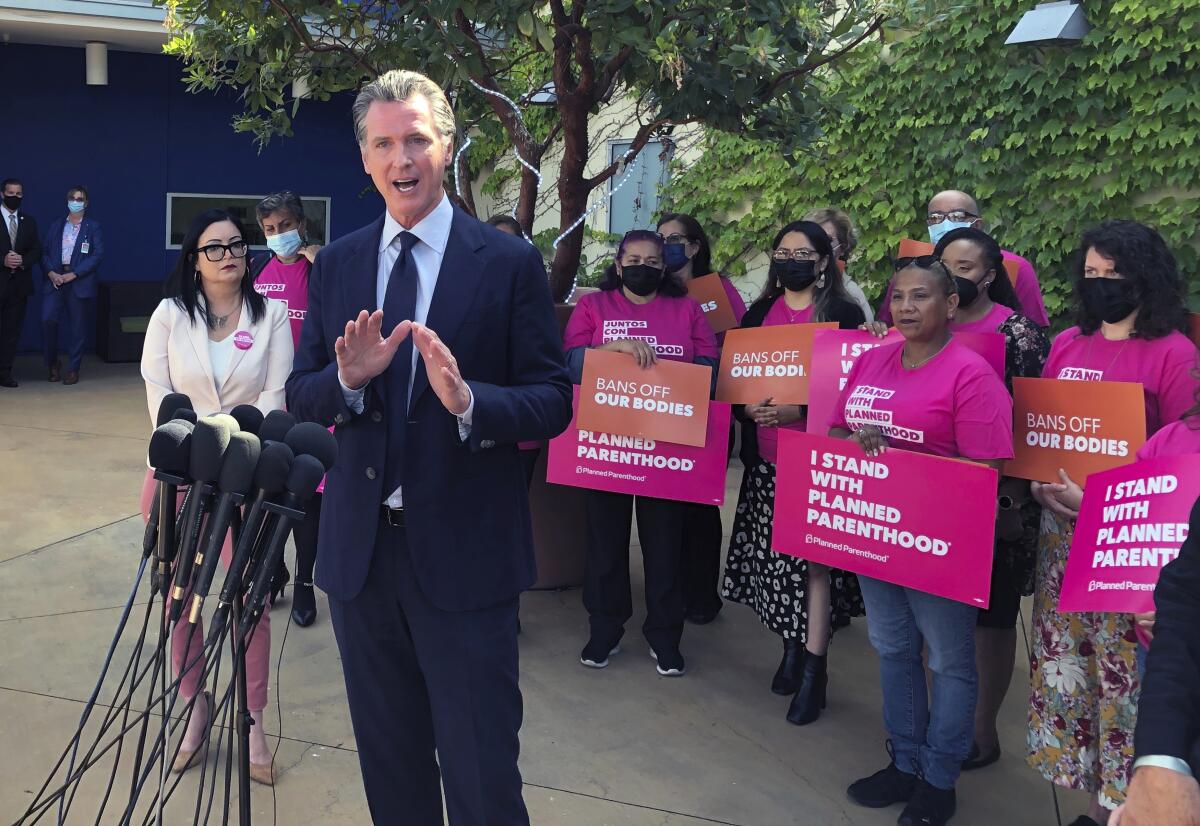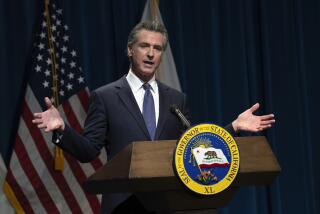Abortion, inflation and crime: How Newsom would spend record-setting California surplus

Gov. Gavin Newsom’s $300.6-billion state budget proposal was sent to the California Legislature on Friday, a far-reaching plan to use a historic tax surplus to boost both government services and the size of the state’s cash reserves.
Lawmakers are required to send a final plan to Newsom’s desk by June 15. California government’s fiscal year begins on July 1.
The governor’s proposal spans both long-term investments and immediate cash rebates, largely made possible by a towering $97.5-billion tax surplus through next summer. Over the last decade, the state’s economy has produced tax revenues that erased years of budget deficits. Other new services would be paid for through traditional state general fund programs.
$18.1 billion to offset high inflation
Newsom’s budget would set aside almost 19% of the tax surplus for immediate cash rebates and a variety of assistance programs for low-income residents.
Most of the money — $11.1 billion — would be distributed through cash deposits or debit cards in the late summer. The governor has proposed doing so through $400 payments to vehicle owners, seeking to mitigate the high price of fuel. State sales taxes assessed on diesel fuel would be suspended for a year. Free rides on public transit would be made available through $750 million in subsidies.
Hospital and skilled nursing facility workers would be eligible for $1,500 stipends, rising to $2,000 per worker if employers chip in.
Low-income renters who applied for rental assistance this spring would receive $2.7 billion in cash aid, fully funding a program that has left some Californians waiting for help. And existing programs providing help with unpaid utility bills would receive $1.4 billion.
Subsidies for private healthcare plans purchased under Covered California would be extended for families of four earning up to $166,500.
$47.1 billion for climate, drought, wildfire impacts
Newsom’s budget proposal seeks a boost in multi-year efforts to combat the effects of climate change — most notably, the dangers brought about by wildfire threats and worsening drought.
Almost two-thirds of those funds would be used for an expansion of electric vehicle infrastructure, more zero-emission vehicles and buses, an electricity reserve to boost power grid reliability and far-reaching public transit efforts that include the final installment of bonds earmarked for high-speed rail.
The budget plan envisions $2.7 billion in spending on wildfire prevention, including forest thinning and prescribed burns. Water supplies would be boosted in low-income communities. Some farmers and other agriculture businesses would be eligible for $50,000 grants to help cope with drought impacts, and $1.1 billion would be spent on new sustainable farming practices.
$128 billion for public schools
Funding for K-12 education and community colleges would rise sharply under Newsom’s budget, largely driven by mandates in the California Constitution that set aside roughly 40 cents of every tax dollar for schools. That means a large part of the surplus will go to programs focused on students, teachers and schools.
Some child care fees would be waived and summer school programs would see new money, while additional dollars would go toward the creation of transitional kindergarten across California. Children’s mental health and special education programs would see boosts.
When viewed across federal and state funds, state officials say the budget proposal would raise per-pupil spending in California’s public schools to $22,850, a record high.
COVID-19 and public safety boosts
California has spent heavily on COVID-19 pandemic efforts over the last two years, such as personal protective equipment for first responders and broader access to virus testing and vaccines. Newsom’s latest budget plan would commit an additional $1.1 billion to these efforts, including testing in public schools and public health services.
Public safety programs also would see a boost, with several efforts linked to concerns over crime rates that have risen recently in some communities. The governor’s staff pegs the total allocation for these programs at $660 million — led by a $262-million effort to address the persistent opioid crisis. The budget calls for a new task force to confront fentanyl use and distribution.
Victims of child sex trafficking would be eligible for assistance grants and the state would offer additional funding to the Internet Crimes Against Children Task Force.
Newsom’s January budget plan committed $285 million to public safety programs that included new responses to retail theft across California.
With Roe vs. Wade in jeopardy, new abortion services help
Lawmakers are likely to embrace, if not enhance, the governor’s budget proposal to improve and extend abortion services offered in California — especially given that some communities still have limited resources for women seeking medical treatment.
The recent uproar over a draft U.S. Supreme Court ruling that would overturn Roe vs. Wade has led to a $125-million proposal that, in some cases, could provide services to women who travel to California from other states seeking abortion services. That includes $40 million in grants to reproductive healthcare providers whose clients don’t have health insurance.
The budget proposes spending on outreach programs covering sexual health and reproductive issues. It also removes some Medi-Cal requirements that may not be medically necessary and $20 million for technology and security upgrades at some reproductive healthcare facilities.
More to Read
Start your day right
Sign up for Essential California for news, features and recommendations from the L.A. Times and beyond in your inbox six days a week.
You may occasionally receive promotional content from the Los Angeles Times.







